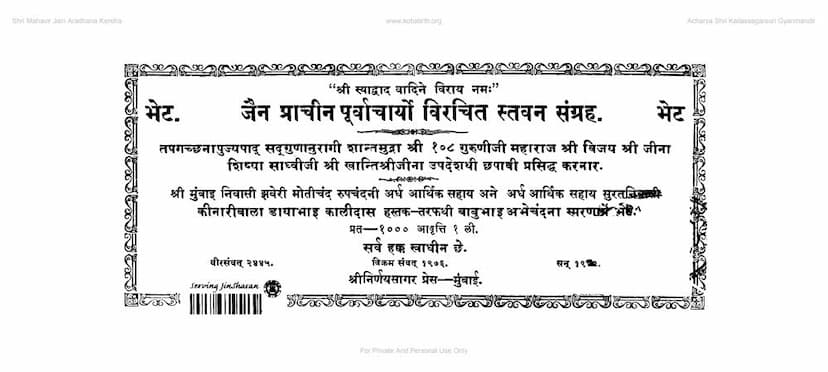Jain Prachin Purvacharyo Virachit Stavan Sangrah
Added to library: September 2, 2025

Summary
This is a comprehensive summary of the Jain text "Jain Prachin Purvacharyo Virachit Stavan Sangrah" authored by Motichand Rupchand Zaveri, based on the provided pages.
Book Title: Jain Prachin Purvacharyo Virachit Stavan Sangrah (Collection of Stanzas Composed by Ancient Jain Acharyas) Author(s): Motichand Rupchand Zaveri Publisher: Motichand Rupchand Zaveri Publication Details:
- Published in Veer Samvat 2445 / Vikram Samvat 1976 (1919 AD).
- Printed by Ramchandra Yesu Shedge at the "Nirnaya Sagar" Press, Bombay.
- The book was published with the inspiration of Sadhvi Ji Shri Khanti Shri Ji, a disciple of Guruni Ji Maharaj Shri Vijay Shri Ji of the Tapagachha.
- Half of the financial assistance came from Zaveri Motichand Rupchand of Bombay, and the other half from Kinariwala Dayabhai Kalidas of Surat, in memory of Babubhai Abhechand.
- A thousand copies were printed for the first edition.
- The book is intended for private and personal use.
Core Purpose and Philosophy (as explained in the Avataranika/Preface):
The primary goal of this compilation is to present stanzas (stavan) composed by revered ancient Jain Acharyas. The text emphasizes the importance of these traditional stanzas for their devotional content, their ability to evoke profound emotions, and their role in uplifting the spirit.
The preface highlights a perceived decline in the practice of singing or reciting these older, more spiritually resonant stanzas in modern times. It laments that contemporary compositions, while perhaps stylistically different, often fail to evoke the same depth of inner joy, devotion, and spiritual understanding. The book aims to revive the appreciation and practice of these ancient devotional hymns, suggesting that merely memorizing them or reciting them mechanically is insufficient. True benefit comes from understanding the essence and inner meaning of the stanzas and internalizing them in one's heart.
The principle "यादृशी भावना यस्य, सिद्धिर्भवति तादृशी" (As is the feeling in one's mind, so is the attainment of accomplishment) is cited to underscore the importance of understanding the devotional sentiment within the stanzas.
Content Overview (as indicated by the Anukramanika/Index):
The collection includes a diverse range of stanzas, primarily focusing on various Jain Tirthankaras, key spiritual concepts, and important rituals or festivals. The index lists 46 stanzas, along with a "Shri Mahavir Tap Namaskar." Some of the prominent stanzas mentioned include:
- Stanzas on the five great auspicious events (Panch Kalyanaka) of various Tirthankaras, such as Shri Shantinath, Shri Mahavir Swami, and the 24 Tirthankaras.
- Stanzas on specific deities or revered figures, like Shri Gautam Swami, Shri Parshvanathji, and Shri Simandhar Swami.
- Stanzas related to important Jain principles and practices, such as:
- Panchkalyanaka (Five auspicious events)
- Panchkaran (Fivefold action/principles)
- Akshay Nidhi Tap (A specific austerity)
- Shashvat Jinvar (Eternal Tirthankaras)
- Samayik (Equanimity practice)
- Pratikraman (Confession and repentance)
- Upadhan Vidhi (A ritualistic austerity)
- Samavsaran (The divine assembly of Tirthankaras)
- Samyaktva Vichar (Reflection on Right Faith)
- Alpa Bahutva Vichar (Discussion on relative quantities/magnitudes)
- Dasvidha Pacchakkhana (Ten types of vows/renunciations)
- Shap Parvi Adhikar (Discussions on six stages of spiritual progress)
- Sanyam Shreni (Stages of spiritual discipline)
- Saubhagya Panchami and Gyan Panchami (Specific festival-related stanzas)
- Jain Tirth related stanzas, like those of Arbudaachal.
Inclusion of a Biography:
The text also includes a brief biography of swav. Babubhai Abhechand, presumably the individual for whom the financial contribution was made in memory. The biography mentions his birth in Surat, his father's passing at a young age, his mother and uncle raising him, and his education at the Shri Ratnasagar Ji Jain Vidyashala, which provided both religious and practical learning. It notes his promising academic performance but laments his premature death in Samvat 1968 (1912 AD) due to his short lifespan. The text also mentions his mother's grief leading to her renunciation and taking initiation, as well as the erection of an idol in the Shri Suvidhinathji temple by his uncle Thakorbhai in his memory. It concludes with the sad news of Sadhvi Ji Shri Khanti Shri Ji's passing before the book's publication, and her disciples completing the task.
Overall Impression:
This book is a valuable resource for Jain devotees and scholars interested in traditional Jain devotional literature (stavan). It reflects a conscious effort to preserve and promote the spiritual heritage of Jainism by reintroducing the works of ancient Acharyas, emphasizing their emotional and devotional depth over modern stylistic trends. The inclusion of the biographical sketch adds a personal touch, connecting the publication to individuals and their spiritual journeys.